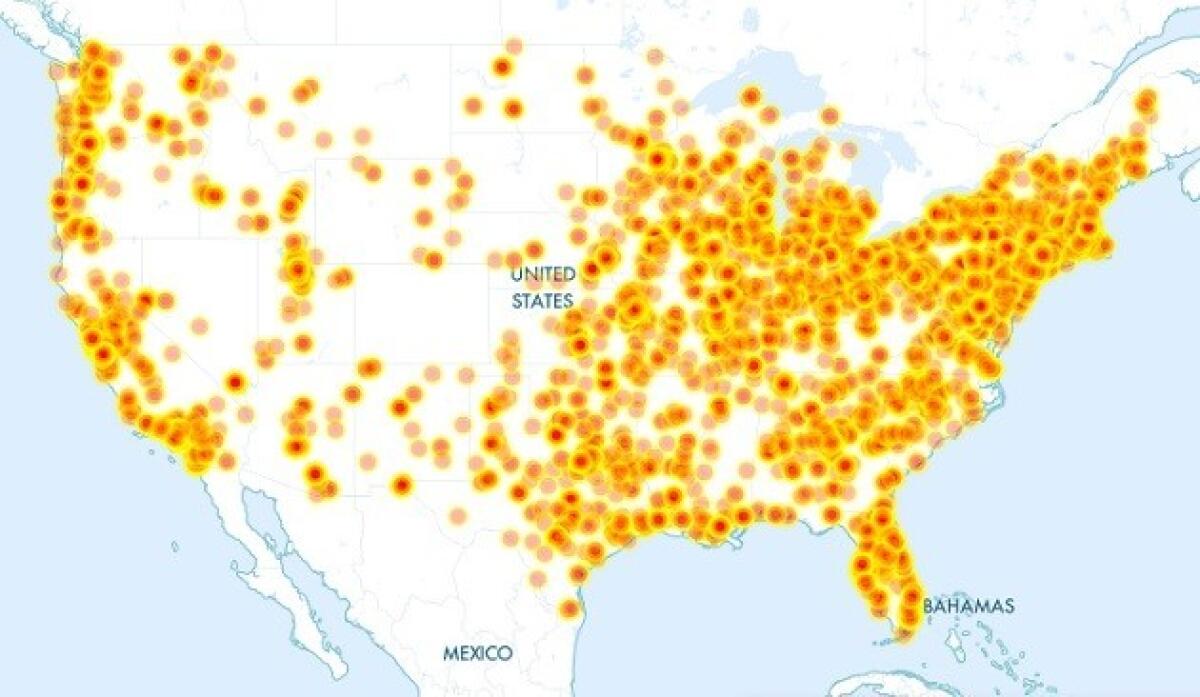Release of Scouts’ files reveals decades of abuse

- Share via
More than 1,200 files on suspected sexual molesters in the Boy Scouts of America were made public Thursday, lifting the veil on decades of alleged abuse in one of the nation’s oldest youth organizations.
The court-ordered release of the files offers a detailed view of how the Scouts handled suspected molestations from the early 1960s through 1985.
Suspected abusers from all over the country are named in the files — many of them never reported to police or charged with a crime. Doctors, lawyers, politicians and policemen are among the accused and many are about to face public exposure for the first time.
DATABASE: Search the “perversion files”
“The secrets are out,” said Kelly Clark, one of the plaintiff’s lawyers in an Oregon lawsuit that resulted in a nearly $20-million judgment against the Scouts in 2010. “Child abuse thrives in secrecy and secret systems are where it breeds.”
Clark’s office made the confidential files public — minus the names of victims and others who reported suspected abuse — after the Oregon Supreme Court ordered their release in June at the request of news organizations including the Oregonian, Oregon Public Broadcasting, the New York Times and the Associated Press. Kept by the Boy Scouts for nearly 100 years, the files were intended for internal use to bar suspected molesters from rejoining the organization.
The Los Angeles Times over the last several months analyzed a larger and slightly more recent batch of files —1,900 cases opened on suspected child abusers from 1970 to 1991. In hundreds of cases, the newspaper found, the Scouts failed to report abuse to authorities and many times covered up allegations to protect the organization’s reputation. The Times also found that dozens of men who were expelled on suspicion of sexual abuse managed to reenter the organization only to face new allegations.
The Times is incorporating the files released Thursday into its own online database, which contains information on nearly 5,000 such cases spanning 1947 to January 2005. The database offers a complete record of files opened during that period except for an unknown number of files that have been purged by the Scouts over the years. More than 300 cases involve someone with ties to a troop or unit in California.
FULL COVERAGE: Inside the “perversion files”
Many files include graphic descriptions of abuse by young victims, including a 10-year-old Scout from Georgia who described being raped by his 27-year-year leader on a 1972 camping trip.
“I kept saying I wanted to go back swimming but he said, ‘Just a minute,’ ” the boy wrote.
“I was crying. … I didn’t go on any more camping trips.”
The scoutmaster was not tried in that case, but later was convicted of child sexual abuse and sentenced to 14 years in prison, public records show.
Months ago, The Times obtained the information for its analysis and database from a Seattle attorney, Timothy Kosnoff, who has sued the Scouts more than 100 times on behalf of alleged victims of child abuse.
In a statement Thursday, Boy Scouts’ National President Wayne Perry acknowledged that some allegations of abuse have been mishandled by the Scouts.
“There have been instances where people misused their positions in Scouting to abuse children, and in certain cases, our response to these incidents and our efforts to protect youth were plainly insufficient, inappropriate, or wrong,” Perry said. “Where those involved in Scouting failed to protect, or worse, inflicted harm on children, we extend our deepest and sincere apologies to victims and their families. “
Perry underscored the organization’s enhanced child-protection efforts in recent years, including increased background checks, training and mandatory reporting of all suspected abuse.
Scouting officials have long maintained that analyzing the files would not enhance their efforts to protect Scouts — even after some of their own expert advisers urged them to do such a review. After a judge’s decision to release the files in the Oregon case, however, the organization commissioned a study of hundreds of cases between 1965 and 1985. Janet Warren, a psychiatry professor at the University of Virginia, found no common profile among predators.
Others said the files are of considerable value to researchers and youth groups. “This is the biggest and maybe the only set we have on child abuse in American youth organizations,” said Patrick Boyle, who reviewed hundreds of files for his 1994 book “Scouts Honor: Sexual Abuse in America’s Most Trusted Institution.” “It gives us incredible insights
The Times investigation revealed several trends in the files, some of which echo revelations about the Catholic Church and, more recently, the Penn State scandal involving defensive coach Jerry Sandusky.
On Wednesday, the newspaper reported that the files revealed a pattern of grooming behavior, in which men seduced their young victims by offering them gifts, favors, counseling and one-on-one attention. In many cases, the alleged molesters spent time alone with Scouts — a practice long discouraged by the organization and formally prohibited in 1987.
In September, The Times reported that the Boy Scouts failed to report hundreds of alleged child molesters to police and often hid the allegations from parents and the public.
Scouting officials frequently urged admitted offenders to quietly resign and helped many cover their tracks, allowing them to cite bogus reasons for their departure.
In 80% of the 500 cases in which the Scouts were the first to learn about abuse, there is no record of Scouting officials reporting the allegations to police. In more than 100 of the cases, officials actively sought to conceal the alleged abuse or allowed the suspects to hide it, The Times found.
Nine days after that report, the Boy Scouts announced that it would conduct a comprehensive review of about 5,000 files going back to the 1940s and would report to law enforcement any cases it had not previously disclosed.
In August, The Times reported that the blacklist, for years the primary line of defense against child molesters, was repeatedly breached. In more than 125 cases, men allegedly continued to molest Scouts after the organization was first presented with allegations of abusive behavior.
Predators slipped back into the program by falsifying personal information or skirting the registration process. Others were able to jump from troop to troop around the country thanks to clerical errors, computer glitches or the Scouts’ failure to check the blacklist.
Media organizations across the country are expected to mine the files released Thursday, and legal experts say that some of the revelations could lead to more lawsuits against the Boy Scouts.
Times researcher Maloy Moore contributed to this report.
More to Read
Sign up for Essential California
The most important California stories and recommendations in your inbox every morning.
You may occasionally receive promotional content from the Los Angeles Times.











